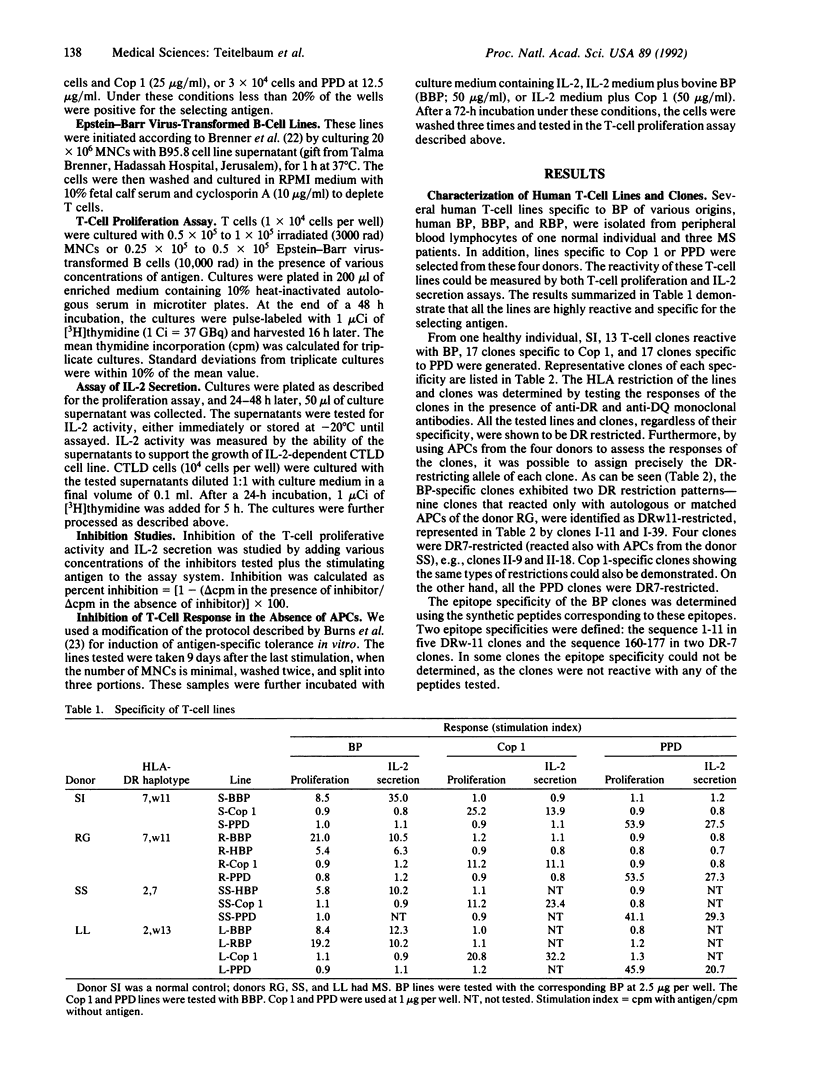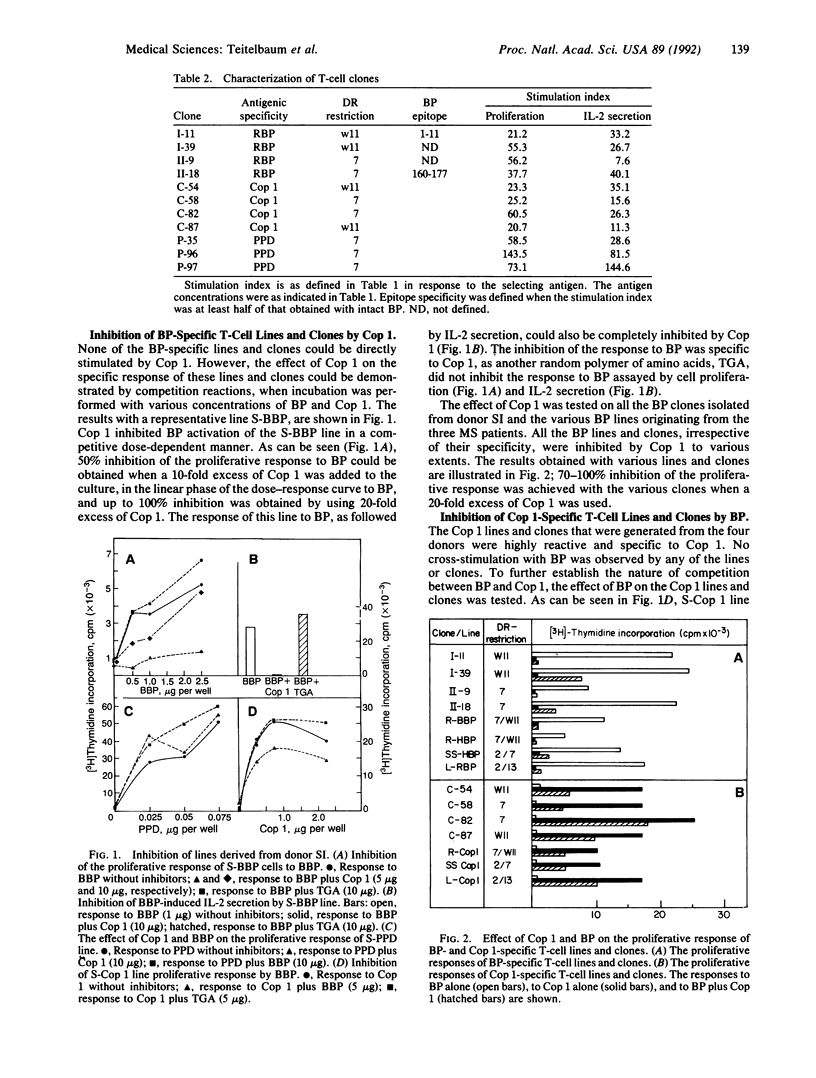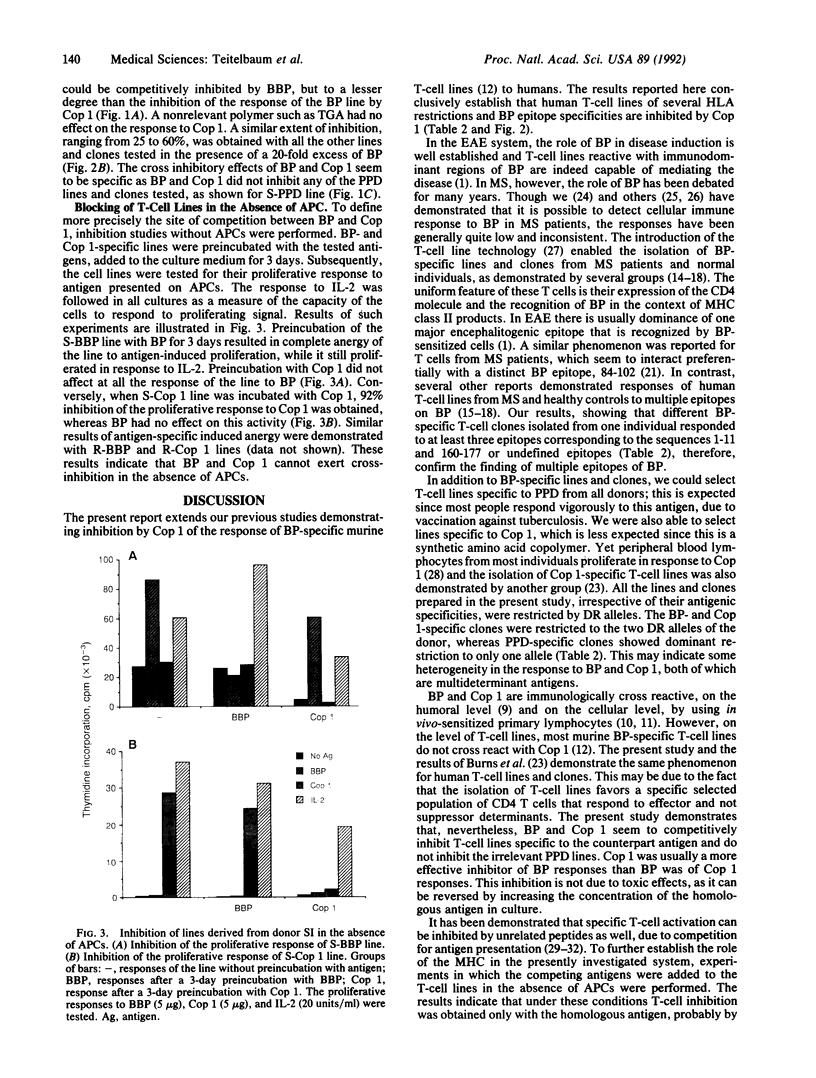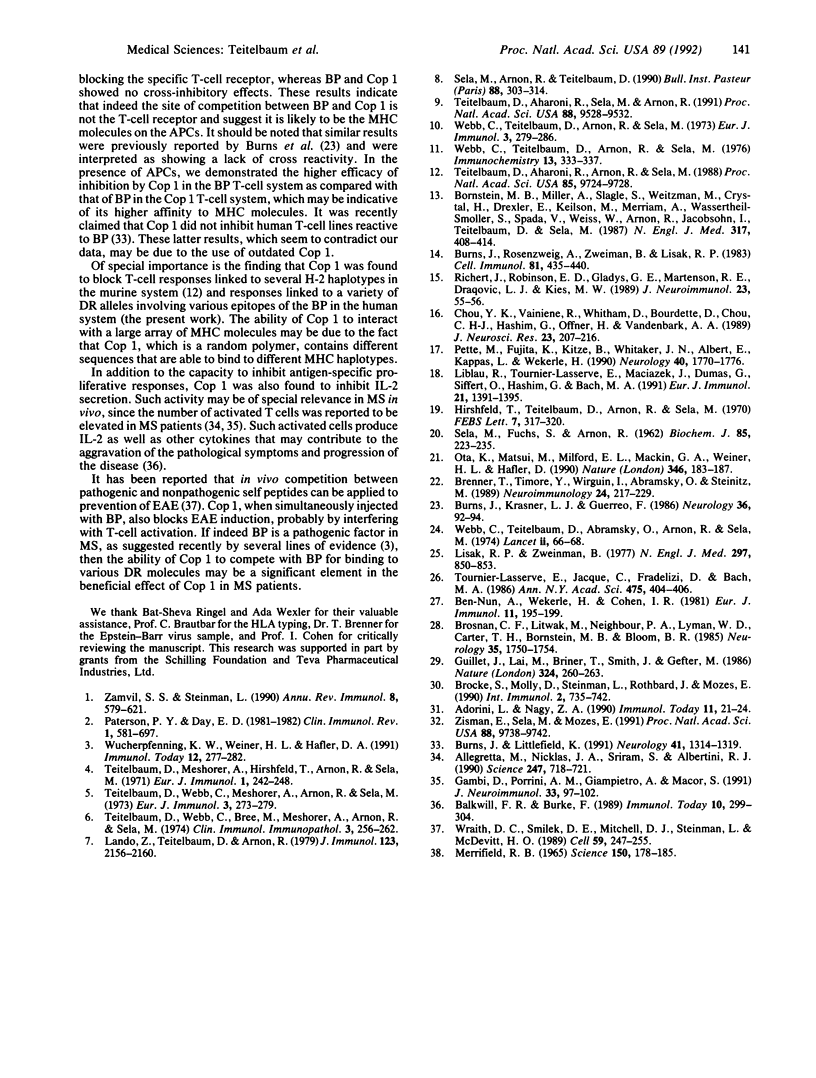Abstract
Copolymer 1 (Cop 1) is a synthetic basic random copolymer of amino acids that has been shown to be effective in suppression of experimental allergic encephalomyelitis and has been proposed as a candidate drug for multiple sclerosis. Cop 1 is immunologically cross reactive with myelin basic protein (BP) and was shown to inhibit murine BP-specific T-cell lines of various H-2 restrictions. In the present study these findings were extended to include human T-cell lines. Cop 1 competitively inhibited the proliferative responses and interleukin 2 secretion of six BP-specific T-cell lines and 13 clones with several DR restrictions and epitope specificities. Conversely, BP inhibited--albeit to a lesser extent--the response of all the Cop 1-specific T-cell lines and clones, irrespective of their DR restrictions. Another random copolymer of tyrosine, glutamic acid, and alanine, denoted TGA, had no effect on these lines. Neither Cop 1 nor BP inhibited the response of lines and clones specific for purified protein derivative. Cop 1 and BP exerted their cross-inhibitory effects only in the presence of antigen-presenting cells. These results suggest that Cop 1 can compete with BP for the binding to human major histocompatibility complex molecules. In view of recent studies implicating BP reactivity in multiple sclerosis, these findings suggest a possible mechanism for the beneficial effect of Cop 1 in this disease.
Full text
PDF




Images in this article
Selected References
These references are in PubMed. This may not be the complete list of references from this article.
- Adorini L., Nagy Z. A. Peptide competition for antigen presentation. Immunol Today. 1990 Jan;11(1):21–24. doi: 10.1016/0167-5699(90)90006-u. [DOI] [PubMed] [Google Scholar]
- Allegretta M., Nicklas J. A., Sriram S., Albertini R. J. T cells responsive to myelin basic protein in patients with multiple sclerosis. Science. 1990 Feb 9;247(4943):718–721. doi: 10.1126/science.1689076. [DOI] [PubMed] [Google Scholar]
- Balkwill F. R., Burke F. The cytokine network. Immunol Today. 1989 Sep;10(9):299–304. doi: 10.1016/0167-5699(89)90085-6. [DOI] [PubMed] [Google Scholar]
- Ben-Nun A., Wekerle H., Cohen I. R. The rapid isolation of clonable antigen-specific T lymphocyte lines capable of mediating autoimmune encephalomyelitis. Eur J Immunol. 1981 Mar;11(3):195–199. doi: 10.1002/eji.1830110307. [DOI] [PubMed] [Google Scholar]
- Bornstein M. B., Miller A., Slagle S., Weitzman M., Crystal H., Drexler E., Keilson M., Merriam A., Wassertheil-Smoller S., Spada V. A pilot trial of Cop 1 in exacerbating-remitting multiple sclerosis. N Engl J Med. 1987 Aug 13;317(7):408–414. doi: 10.1056/NEJM198708133170703. [DOI] [PubMed] [Google Scholar]
- Brenner T., Timore Y., Wirguin I., Abramsky O., Steinitz M. In vitro synthesis of antibodies to acetylcholine receptor by Epstein-Barr virus-stimulated B-lymphocytes derived from patients with myasthenia gravis. J Neuroimmunol. 1989 Oct;24(3):217–222. doi: 10.1016/0165-5728(89)90119-7. [DOI] [PubMed] [Google Scholar]
- Brocke S., Dayan M., Steinman L., Rothbard J., Mozes E. Inhibition of T cell proliferation specific for acetylcholine receptor epitopes related to myasthenia gravis with antibody to T cell receptor or with competitive synthetic polymers. Int Immunol. 1990;2(8):735–742. doi: 10.1093/intimm/2.8.735. [DOI] [PubMed] [Google Scholar]
- Brosnan C. F., Litwak M., Neighbour P. A., Lyman W. D., Carter T. H., Bornstein M. B., Bloom B. R. Immunogenic potentials of copolymer I in normal human lymphocytes. Neurology. 1985 Dec;35(12):1754–1759. doi: 10.1212/wnl.35.12.1754. [DOI] [PubMed] [Google Scholar]
- Burns J., Krasner L. J., Guerrero F. Human cellular immune response to copolymer I and myelin basic protein. Neurology. 1986 Jan;36(1):92–94. doi: 10.1212/wnl.36.1.92. [DOI] [PubMed] [Google Scholar]
- Burns J., Littlefield K. Failure of copolymer I to inhibit the human T-cell response to myelin basic protein. Neurology. 1991 Aug;41(8):1317–1319. doi: 10.1212/wnl.41.8.1317. [DOI] [PubMed] [Google Scholar]
- Burns J., Rosenzweig A., Zweiman B., Lisak R. P. Isolation of myelin basic protein-reactive T-cell lines from normal human blood. Cell Immunol. 1983 Oct 15;81(2):435–440. doi: 10.1016/0008-8749(83)90250-2. [DOI] [PubMed] [Google Scholar]
- Chou Y. K., Vainiene M., Whitham R., Bourdette D., Chou C. H., Hashim G., Offner H., Vandenbark A. A. Response of human T lymphocyte lines to myelin basic protein: association of dominant epitopes with HLA class II restriction molecules. J Neurosci Res. 1989 Jun;23(2):207–216. doi: 10.1002/jnr.490230211. [DOI] [PubMed] [Google Scholar]
- Gambi D., Porrini A. M., Giampietro A., Macor S. CD21+ (B2 antigen+) cell decrement and CD4+CD29+ (helper-inducer) cell increment suggest an activation of cell immune reactivity in multiple sclerosis. J Neuroimmunol. 1991 Aug;33(2):97–102. doi: 10.1016/0165-5728(91)90053-a. [DOI] [PubMed] [Google Scholar]
- Guillet J. G., Lai M. Z., Briner T. J., Smith J. A., Gefter M. L. Interaction of peptide antigens and class II major histocompatibility complex antigens. Nature. 1986 Nov 20;324(6094):260–262. doi: 10.1038/324260a0. [DOI] [PubMed] [Google Scholar]
- Hirshfeld H., Teitelbaum D., Arnon R., Sela M. Basic encephalitogenic protein: A simplified purification on sulphoethyl-sephadex. FEBS Lett. 1970 May 1;7(4):317–320. doi: 10.1016/0014-5793(70)80193-4. [DOI] [PubMed] [Google Scholar]
- Lando Z., Teitelbaum D., Arnon R. Effect of cyclophosphamide on suppressor cell activity in mice unresponsive to EAE. J Immunol. 1979 Nov;123(5):2156–2160. [PubMed] [Google Scholar]
- Liblau R., Tournier-Lasserve E., Maciazek J., Dumas G., Siffert O., Hashim G., Bach M. A. T cell response to myelin basic protein epitopes in multiple sclerosis patients and healthy subjects. Eur J Immunol. 1991 Jun;21(6):1391–1395. doi: 10.1002/eji.1830210610. [DOI] [PubMed] [Google Scholar]
- Lisak R. P., Zweiman B. In vitro cell-mediated immunity of cerebrospinal-fluid lymphocytes to myelin basic protein in primary demyelinating diseases. N Engl J Med. 1977 Oct 20;297(16):850–853. doi: 10.1056/NEJM197710202971602. [DOI] [PubMed] [Google Scholar]
- Merrifield R. B. Automated synthesis of peptides. Science. 1965 Oct 8;150(3693):178–185. doi: 10.1126/science.150.3693.178. [DOI] [PubMed] [Google Scholar]
- Ota K., Matsui M., Milford E. L., Mackin G. A., Weiner H. L., Hafler D. A. T-cell recognition of an immunodominant myelin basic protein epitope in multiple sclerosis. Nature. 1990 Jul 12;346(6280):183–187. doi: 10.1038/346183a0. [DOI] [PubMed] [Google Scholar]
- Paterson P. Y., Day E. D. Current perspectives of neuroimmunologic disease: multiple sclerosis and experimental allergic encephalomyelitis (1,2). Clin Immunol Rev. 1981;1(4):581–697. [PubMed] [Google Scholar]
- Pette M., Fujita K., Kitze B., Whitaker J. N., Albert E., Kappos L., Wekerle H. Myelin basic protein-specific T lymphocyte lines from MS patients and healthy individuals. Neurology. 1990 Nov;40(11):1770–1776. doi: 10.1212/wnl.40.11.1770. [DOI] [PubMed] [Google Scholar]
- Richert J. R., Robinson E. D., Deibler G. E., Martenson R. E., Dragovic L. J., Kies M. W. Evidence for multiple human T cell recognition sites on myelin basic protein. J Neuroimmunol. 1989 Jun;23(1):55–66. doi: 10.1016/0165-5728(89)90073-8. [DOI] [PubMed] [Google Scholar]
- SELA M., FUCHS S., ARNON R. Studies on the chemical basis of the antigenicity of proteins. 5. Synthesis, characterization and immunogenicity of some multichain and linear polypeptides containing tyrosine. Biochem J. 1962 Oct;85:223–235. doi: 10.1042/bj0850223. [DOI] [PMC free article] [PubMed] [Google Scholar]
- Teitelbaum D., Aharoni R., Arnon R., Sela M. Specific inhibition of the T-cell response to myelin basic protein by the synthetic copolymer Cop 1. Proc Natl Acad Sci U S A. 1988 Dec;85(24):9724–9728. doi: 10.1073/pnas.85.24.9724. [DOI] [PMC free article] [PubMed] [Google Scholar]
- Teitelbaum D., Aharoni R., Sela M., Arnon R. Cross-reactions and specificities of monoclonal antibodies against myelin basic protein and against the synthetic copolymer 1. Proc Natl Acad Sci U S A. 1991 Nov 1;88(21):9528–9532. doi: 10.1073/pnas.88.21.9528. [DOI] [PMC free article] [PubMed] [Google Scholar]
- Teitelbaum D., Meshorer A., Hirshfeld T., Arnon R., Sela M. Suppression of experimental allergic encephalomyelitis by a synthetic polypeptide. Eur J Immunol. 1971 Aug;1(4):242–248. doi: 10.1002/eji.1830010406. [DOI] [PubMed] [Google Scholar]
- Teitelbaum D., Webb C., Bree M., Meshorer A., Arnon R., Sela M. Suppression of experimental allergic encephalomyelitis in Rhesus monkeys by a synthetic basic copolymer. Clin Immunol Immunopathol. 1974 Nov;3(2):256–262. doi: 10.1016/0090-1229(74)90012-9. [DOI] [PubMed] [Google Scholar]
- Teitelbaum D., Webb C., Meshorer A., Arnon R., Sela M. Suppression by several synthetic polypeptides of experimental allergic encephalomyelitis induced in guinea pigs and rabbits with bovine and human basic encephalitogen. Eur J Immunol. 1973 May;3(5):273–279. doi: 10.1002/eji.1830030505. [DOI] [PubMed] [Google Scholar]
- Webb C., Teitelbaum D., Arnon R., Sela M. In vivo and in vitro immunological cross-reactions between basic encephalitogen and synthetic basic polypeptides capable of suppressing experimental allergic encephalomyelitis. Eur J Immunol. 1973 May;3(5):279–286. doi: 10.1002/eji.1830030506. [DOI] [PubMed] [Google Scholar]
- Webb C., Teitelbaum D., Herz A., Arnon R., Sela M. Molecular requirements involved in suppression of EAE by synthetic basic copolymers of amino acids. Immunochemistry. 1976 Apr;13(4):333–337. doi: 10.1016/0019-2791(76)90344-x. [DOI] [PubMed] [Google Scholar]
- Wraith D. C., Smilek D. E., Mitchell D. J., Steinman L., McDevitt H. O. Antigen recognition in autoimmune encephalomyelitis and the potential for peptide-mediated immunotherapy. Cell. 1989 Oct 20;59(2):247–255. doi: 10.1016/0092-8674(89)90287-0. [DOI] [PubMed] [Google Scholar]
- Wucherpfennig K. W., Weiner H. L., Hafler D. A. T-cell recognition of myelin basic protein. Immunol Today. 1991 Aug;12(8):277–282. doi: 10.1016/0167-5699(91)90126-E. [DOI] [PubMed] [Google Scholar]
- Zamvil S. S., Steinman L. The T lymphocyte in experimental allergic encephalomyelitis. Annu Rev Immunol. 1990;8:579–621. doi: 10.1146/annurev.iy.08.040190.003051. [DOI] [PubMed] [Google Scholar]
- Zisman E., Sela M., Mozes E. Direct binding of a synthetic multichain polypeptide to class II major histocompatibility complex molecules on antigen-presenting cells and stimulation of a specific T-cell line require processing of the polypeptide. Proc Natl Acad Sci U S A. 1991 Nov 1;88(21):9738–9742. doi: 10.1073/pnas.88.21.9738. [DOI] [PMC free article] [PubMed] [Google Scholar]



